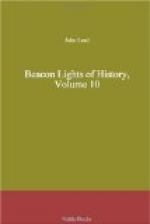Let us now briefly glance at the work done by Gladstone during the five years when in his first premiership he directed the public affairs of England,—impatient of opposition, and sensitive to unjust aspersions, yet too powerful to be resisted in the supreme confidence of his party.
The first thing of note he did was to complete the disestablishment of the Irish Church,—an arduous task to any one lacking Mr. Gladstone’s extraordinary influence. Here he was at war with his former friends, and with a large section of the Conservative party,—especially with ecclesiastical dignitaries, who saw in this measure hostility to the Church as well as a national sin. It was a dissolution of the union between the Churches of England and Ireland; a divestment of the temporalities which the Irish clergy had enjoyed; the abolition of all ecclesiastical corporations and laws and courts in Ireland,—in short, the sweeping away of the annuities which the beneficed clergy had hitherto received out of the property of the Established Church, which annuities were of the nature of freeholds. It was not proposed to deprive the clergy of their income, so long as they discharged their clerical duties; but that the title to their tithes should be vested in commissioners, so that these church freeholds could not be bought and sold by non-residents, and churches in decadence should be taken from incumbents. The peerage rights of Irish bishops were also taken away. It was not proposed to touch private endowments; and glebe-houses which had become generally dilapidated were handed over to incumbents by their paying a fair valuation. Not only did the measure sweep away the abuses of the Establishment which had existed for centuries,—such as endowments held by those who performed no duties, which they could dispose of like other property,—but the regium donum given to Presbyterian ministers and the Maynooth Catholic College grant, which together amounted to L70,000, were also withdrawn, although compensated on the same principles as those which granted a settled stipend to the actual incumbents of the disestablished churches.




